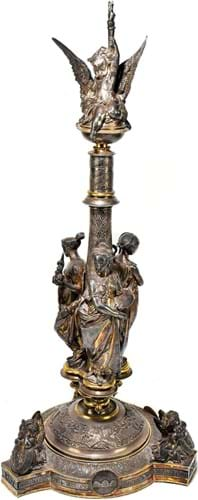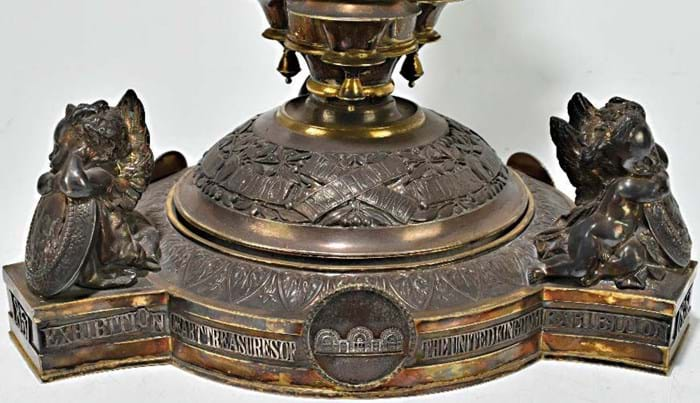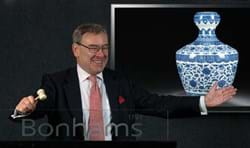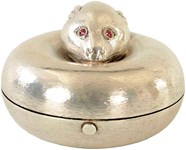
The Manchester Art Treasures Testimonial, a silver centrepiece by John Samuel Hunt sold for £21,000 at Adam Partridge in Macclesfield.
Not everyone had been enthusiastic. William Cavendish, 7th Duke of Devonshire, famously declined the request of the organising committee with the terse reply: “What in the world do you want with art in Manchester? Why can’t you stick to your cotton spinning?”
However, aided by rail excursions of the kind that had filled the Crystal Palace at Hyde Park six years earlier, there were over 1.3m visitors in the 142 days it was open, about four times the total population of Manchester at that point.
The selection and display of artworks in 1857 is thought to have had a formative influence on the public art collections that were then being established in the UK.

The Manchester Art Treasures Testimonial, a silver centrepiece by John Samuel Hunt sold for £21,000 at Adam Partridge in Macclesfield.
Messrs Hunt & Roskell
Two years after the event (the building had been demolished completely by November 1858) the organising committee was presented with a large allegorical silver and parcel gilt centrepiece as a token of thanks.
Called the Testimonial to the Executive Committee of the Manchester Art-Treasures Exhibition, it was pictured in the Illustrated London News in 1860 and later formed part of the Hunt and Roskell display at the 1862 International Exhibition in South Kensington. It was much admired and received a full-page illustration in both the Official Illustrated Catalogue of the International Exhibition of 1862 and JB Waring’s Masterpieces of Industrial Art & Sculpture at the International Exhibition of 1862.
Waring’s guide, published in 1863, discusses the piece alongside others “from the stand of Messrs Hunt & Roskell, London that were designed by Mr HH Armstead, the well-known sculptor”.
Henry Hugh Armstead (1828-1905) had worked for the royal goldsmiths from the age of 18 and modelled and chased a number of important pieces for the 1862 exhibition including the Kean Testimonial, a set of nine pieces presented to the actor Charles Keane.
Waring’s writer continues: “The Manchester Art Treasures Testimonial is surmounted by a figure of Genius contending with an eagle, around which are allegorical figures of Painting, Sculpture and Industrial Art. On the column are the rose, shamrock and thistle and the motto of the Exhibition from Keats’ Hyperion ‘A thing of beauty is a joy forever’.
“On the vase are the names of the principal artists whose works adorned the exhibition and, on the angles, infantile figures of Fame hold medallion portraits of Michelangelo, Titian and Cellini.”
Super centrepiece
It was a description that fitted perfectly the opening lot in the mammoth Adam Partridge (20% inc VAT buyer’s premium) sale held in Macclesfield from February 15-18.
Standing 2ft 8in (80cm) high and weighing 227oz, this centrepiece was hallmarked for John Samuel Hunt and the date letter 1859.
It formed part of a large collection of exhibition-related memorabilia that included the massive Doulton vase from the 1878 Exposition Universelle in Paris sold for £15,000 and pictured on the front page of ATG No 2531.
The centrepiece will require cleaning and some small replacements. To the base, five letters are lost to the word Exhibition while the word Kingdom is also missing. However, it will be considered the rediscovery of a great piece of 19th century English silver. Estimated at £2000-3000 (around the bullion value), it was competed to £21,000.
Remarkably, this is the second major piece of exhibition silver to have emerged for sale in the UK regions this year.
As reported in ATG No 2528, the Celestial Cup, a Chinese ‘export’ silver trophy cup c.1850, sold for £26,000 to S&J Stodel of the London Silver Vaults at Lawrences of Crewkerne on January 18. It was on display at The Great Exhibition of 1851 and is recorded in Robert Hunt’s handbook to the event.














